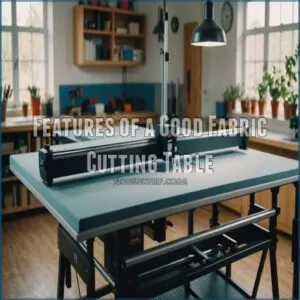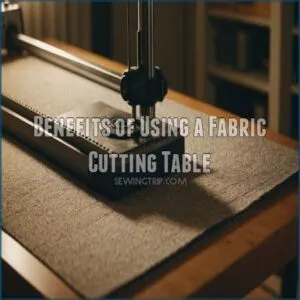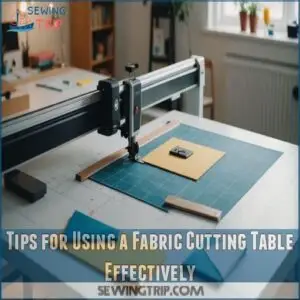This site is supported by our readers. We may earn a commission, at no cost to you, if you purchase through links.
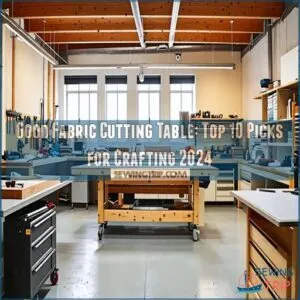 If your dining room table is covered with fabric scraps, it’s time for a good fabric cutting table!
If your dining room table is covered with fabric scraps, it’s time for a good fabric cutting table!
A reliable table offers a dedicated space with enough room for sprawling projects.
Look for features like adjustable height for back-friendly crafting, sturdy materials like MDF or aluminum, and essential storage options to keep your chaos under control.
Portability is a plus, with caster wheels for moving your creative hub around.
A good fabric cutting table is a crucial part of a well-organized craft room, complete with craft room furniture essentials like a height-adjustable desk and multipurpose furniture for maximizing space. With the right table, you’ll prevent scratches on fine furniture and have your craft room running like a well-oiled machine.
And who knows, maybe even your cat will approve.
Table Of Contents
- Key Takeaways
- Features of a Good Fabric Cutting Table
- Benefits of Using a Fabric Cutting Table
- Top 10 Fabric Cutting Tables
- 1. Hobby Cutting Table With Storage
- 2. South Shore White Craft Table With Storage
- 3. Arrow Gidget II Folding Craft Table
- 4. Foldable Hobby Cutting Grid Table
- 5. Sewing Crafting Cabinet Table
- 6. Sew Ready Fabric Cutting Table
- 7. Adjustable Height Folding Table
- 8. Height Adjustable Craft Table with Storage
- 9. Sewing Machine Table with Storage
- 10. Portable White Sewing Table
- Choosing The Right Fabric Cutting Table
- Tips for Using a Fabric Cutting Table Effectively
- Frequently Asked Questions (FAQs)
- Conclusion
Key Takeaways
- You’ll need a sturdy, large enough table to comfortably handle your projects, preventing damage to other surfaces.
- Consider portability and storage; caster wheels and foldable designs maximize space and flexibility.
- Prioritize adjustable height for ergonomic comfort and to prevent back strain during long crafting sessions.
- Check the weight capacity, construction material (MDF, aluminum, steel), and warranty before purchasing to ensure durability and longevity.
Features of a Good Fabric Cutting Table
When you’re hunting for a fabric cutting table, think about size, weight capacity, and whether the table can support your wildest quilting dreams without collapsing.
Make sure it’s portable with plenty of storage; you need a sturdy build that handles everyday wear, preferably with adjustable height so your back doesn’t bear the brunt of those late-night sewing marathons.
Table Size and Weight Capacity
When tackling large projects, don’t underestimate your fabric cutting table‘s size and weight capacity.
A small table might work for light fabrics, but a sewing table designed for heavy fabric is essential.
You can find various options suitable for your needs by checking a fabric cutting table.
Consider space limitations and make sure your table weight supports your needs, like holding a cutting mat or extra storage space.
Making the right choice ensures easy crafting!
Portability and Storage Options
Size and weight matter, but portability and storage options make life easier.
Imagine moving your table with simple caster wheels or folding it neatly to tuck away.
Need a rolling table? Choose one that transforms your sewing room into a mobile workspace.
Beyond compact storage, these clever designs maximize space and keep you organized, adding much-needed flexibility to your crafting experience.
Build Material and Durability
Choosing the right build material impacts your fabric cutting table’s durability.
Steel vs. aluminum?
Steel offers stability, while aluminum provides lightness.
MDF and laminate tops withstand heavy-duty crafting.
Tabletop coatings fend off scratches during those intense sewing sessions.
Opt for construction materials ensuring long-term stability, making your sewing or craft table a reliable craft buddy that won’t buckle under pressure.
Adjustable Height and Comfort
Imagine transforming your sewing space into a haven of comfort with an ergonomically designed table.
Adjustable height is key, allowing you to personalize your standing desk or sewing chair experience.
Here’s the scoop:
- Ergonomic Design enhances posture.
- Height Adjustment prevents back strain.
- Sewing Chair Compatibility for flexibility.
- Smooth Movement between sewing and cutting.
Benefits of Using a Fabric Cutting Table
Imagine yourself effortlessly cutting fabric on a dedicated surface, no more wrestling with patterns on your dining room table!
A fabric cutting table provides a large, stable workspace, preventing accidental cuts and improving your overall sewing experience.
Dedicated Workspace for Sewing and Crafting
A dedicated workspace for sewing and crafting transforms chaos into creativity.
Your fabric cutting table is more than a surface; it’s where dreams materialize with each precise cut.
With a well-organized sewing space, such as one utilizing effective sewing room organization ideas, room to organize sewing supplies, ideal for any sewing room design or craft room essential, it’s like having an extra pair of helping hands.
| Features | Benefits | Uses |
|---|---|---|
| Adjustable height | Comfort | Quilting table |
| Sturdy design | Stability | Dressmaking table |
| Ample storage | Organization | Sewing accessories |
| Foldable option | Space saving | DIY table upgrades |
| Large surface | Efficiency | Sewing room organization |
Prevention of Marks and Stains on Other Surfaces
Your fabric cutting table can save your surfaces from pesky stains.
With specialized tabletop materials, you won’t fret about cutting marks.
Here’s the scoop:
- Fabric protection: Keep your dining table scratch-free.
- Stain removal: Easier cleanup with contained messes.
- Cutting mat use: Boosts table life and protects projects.
The best craft table is a simple lifesaver!
Improved Comfort and Efficiency
Having a well-designed fabric cutting table in your workspace is a game-changer.
With its ergonomic design and thoughtful workspace layout, you’ll breeze through projects using time-saving tools and organized storage solutions.
Imagine a spacious sewing table where chaos gives way to order, letting you focus on creativity.
Plus, a DIY table keeps sewing tools and equipment neatly within reach.
Sturdy Platform for Larger Projects
When tackling large quilt cutting or working with multiple sewing machines, you’ll appreciate the reliable foundation a sturdy fabric cutting table offers, such as the spacious work surface of a Sew Ready Cutting Table.
It meets project space needs with ease, ensuring sewing machine stability across various designs.
Consider tables with an adequate weight limit and dimensions that suit your top picks, blending practicality with room for creative freedom.
Top 10 Fabric Cutting Tables
Choosing the right fabric cutting table can transform your crafting space into an organized haven, whether you’re a quilting pro or just someone seeking an excuse for more storage.
Fabric cutting tables with features like foldable designs and adjustable heights are perfect for making the most of your creative adventures without breaking a sweat—unless, of course, you’re quilting in July.
1. Hobby Cutting Table With Storage
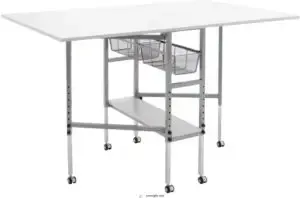
Imagine this: you’re diving into a crafting marathon, and a Hobby Cutting Table with ample storage is your secret weapon.
It’s stylish, with a spacious top for projects, plus mesh drawers and a lower shelf keep your tools handy but out of sight.
The adjustable height means no more backaches after a long session.
It’s mobile, too, thanks to caster wheels, perfect for rearranging your creative workspace.
Crafting pros love it, though some assembly is needed.
Nevertheless, it’s great overall value!
Best For: Crafters who need a spacious and versatile table with storage, adjustable height, and easy mobility.
- Ample storage space with mesh drawers and a lower shelf.
- Adjustable height for comfortable working.
- Mobile with caster wheels for easy rearranging.
- Assembly may be challenging for some.
- Some users have reported quality issues with the table.
- The table is heavy and may require two people to lift.
2. South Shore White Craft Table With Storage
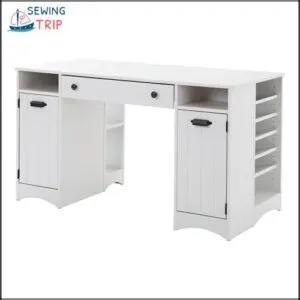
Right now, consider the South Shore White Craft Table. It’s a solid choice for crafters needing ample space and storage. You’ll appreciate its 53" x 24" work surface, perfect for large projects.
Numerous shelves, cabinets, and drawers keep everything organized. While assembly is needed, the sturdy construction, using laminated particleboard, makes it worthwhile.
However, some reviewers mentioned minor assembly issues. Despite this, the table’s overall design and generous storage make it a popular pick. Its pure white finish adds a touch of elegance to your craft room. The five-year warranty offers peace of mind.
Best For: This table is best for crafters who need ample space and storage for their projects.
- Large work surface for spreading out projects
- Plenty of storage shelves, cabinets, and drawers for organization
- Sturdy construction with a five-year warranty
- Some assembly issues reported by customers
- One customer mentioned a door that did not shut properly
- The desk is heavy and may require modifications for stability or mobility
3. Arrow Gidget II Folding Craft Table
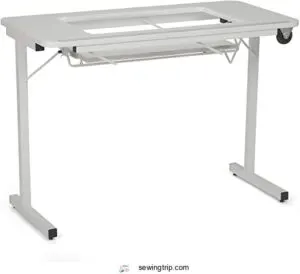
Looking for a versatile craft table?
The Arrow Gidget II Folding Craft Table might be your answer.
This table is a breeze to set up and fold, making it ideal for small spaces or as a portable option.
Its sturdy steel base guarantees no shaking during use.
You’ll appreciate its built-in measuring decal and compatibility with custom acrylic inserts, even though the insert is an added cost.
While it could use better wheel placement, a dolly can make transport effortless.
Perfect for classes or as a second sewing table!
Best For: The Arrow Gidget II Folding Craft Table is best for sewers who need a sturdy and versatile table for small spaces, classes, or as a second sewing table.
- Solid and sturdy construction.
- Fits most sewing machines.
- Easy to set up and fold.
- Acrylic insert for machine is not included and can be expensive.
- Wheels could be positioned better for easier transport.
- Heavy and difficult to lift.
4. Foldable Hobby Cutting Grid Table
Craving a versatile workspace? The Foldable Hobby Cutting Grid Table is your answer.
With its spacious top, marked grids, and adjustable height, it fits perfectly into your crafting rhythm.
Though a bit tricky to assemble, the stability and practicality it offers are unmatched.
Glide it around on its six casters, settling easily with lockable wheels.
Plus, enjoy organized storage with mesh drawers and a lower shelf.
Just watch out for the hefty box it arrives in—your projects will thank you!
Best For: This table is ideal for crafters, sewers, and anyone who needs a spacious and adjustable workspace.
- Spacious tabletop with marked grids for easy measuring.
- Adjustable height for comfortable working.
- Offers storage with drawers and a lower shelf.
- Can be heavy and tricky to assemble.
- Some users reported issues with the screws damaging the top center piece.
- Not suitable for roller cutters, as it can dull them.
5. Sewing Crafting Cabinet Table
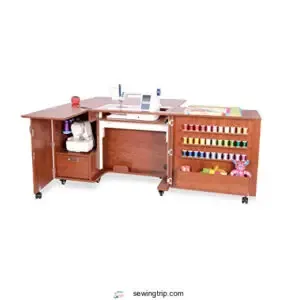
Imagine a creation station that incorporates a sewing desk with cubbies for optimal storage, considering the right table size, like the Sewing Crafting Cabinet Table, that transforms your sewing space into an organized paradise.
With a 3-position hydraulic lift, it effortlessly manages most sewing machines, leaving you free to focus on your creativity.
The rear quilt leaf expands the workspace, adding a delightful touch of convenience.
Beware, though; assembly can be tricky, with confusing instructions and occasionally missing parts.
Despite its higher price tag, the cabinet offers substantial benefits for those who embrace the art of sewing.
Best For: Those who want a versatile and spacious sewing station with a hydraulic lift.
- Effortless machine management with a 3-position hydraulic lift.
- Enhanced workspace with a rear quilt leaf.
- Convenient serger foldout leaf and full view, soft-closing drawer technology.
- Assembly can be challenging with unclear instructions and potential missing parts.
- Some users reported issues with the quality of certain components.
- The cabinet is expensive.
6. Sew Ready Fabric Cutting Table
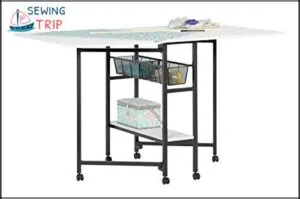
The Sew Ready Fabric Cutting Table is often your go-to for crafting, thanks to its versatile design.
With foldable panels and a sturdy MDF build, it fits any space.
Two slide-out wire mesh drawers keep your tools handy, while the bottom shelf offers extra storage.
Mobility is a breeze with six caster wheels, four of which lock to prevent any impromptu glides.
It might tip on uneven floors, so keep it level.
Best For: Crafters who need a large, sturdy work surface with plenty of storage space.
- Spacious tabletop for spreading out fabric and patterns.
- Two slide-out drawers for organizing tools and supplies.
- Six casters for easy mobility, with four locking for stability.
- Can be difficult to assemble and may require help.
- May tip on uneven floors.
- Expensive compared to other crafting tables.
7. Adjustable Height Folding Table
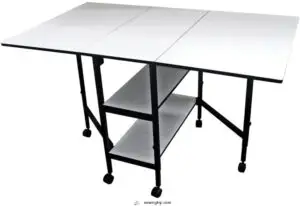
With an Adjustable Height Folding Table, you get both versatility and ease of use.
This table’s height can change from 29 to 38 inches, making it perfect for various projects, whether you’re quilting or crafting.
The laminate surface provides a sturdy area for cutting fabrics, while caster wheels allow you to move it around effortlessly.
Keep in mind, though, it might wobble at its maximum height.
Easy assembly and foldability make this table a great choice for those tight on space.
Best For: This table is best for crafters, quilters, and anyone needing a versatile workspace that’s easy to store.
- Adjustable height for various tasks
- Laminate surface for durability
- Easy assembly and storage
- May wobble at the highest setting
- Difficult to adjust height
- Some reports of shipping issues
8. Height Adjustable Craft Table with Storage
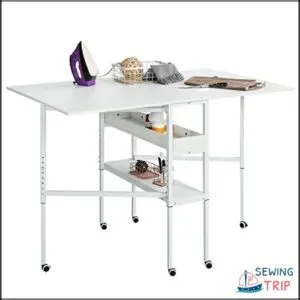
When choosing a sewing table, consider the importance of a smooth work surface for precise fabric handling and optimal table size guidelines. A height adjustable craft table with storage is a game-changer for any sewing enthusiast.
Adjust the height from 33" to nearly 40", letting you find that sweet spot for comfort while crafting.
Need storage? It’s got you covered with two sturdy shelves, plus locking casters make it a breeze to move around or stow away.
Although assembly is needed, this table provides solid value for its price, offering a blend of durability and functionality that’s hard to pass up.
Best For: This height-adjustable craft table with storage is perfect for crafters, hobbyists, and anyone needing a versatile and functional workspace.
- Height adjustable to accommodate different users and tasks
- Includes storage shelves for organizing crafting supplies
- Features locking casters for easy movement and storage
- Requires assembly
- Height adjustment requires repositioning bolts
- Some users reported receiving damaged parts
9. Sewing Machine Table with Storage
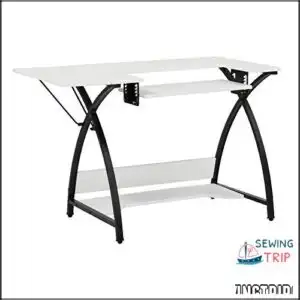
Often, crafters need a dedicated space.
This Sew Ready sewing machine table offers just that!
You’ll appreciate its adjustable sewing machine shelf, roomy tabletop, and ample storage.
The sturdy steel construction provides stability, while the foldable shelf adds convenience.
It’s a great value, although some users mention the sewing machine platform can shake.
Consider adjustable feet for uneven floors.
Overall, it’s a practical choice for organized sewing.
You’ll love having everything you need within easy reach!
Remember to check the weight limits before loading it up.
Best For: The Sew Ready sewing machine table, known for its heavy gauge steel construction, is one of the top picks for sewing machine tables cabinets, as seen in the top picks for sewing machine tables cabinets here. This Sew Ready sewing machine table is best for crafters who need a dedicated space with ample storage and adjustable features.
- Offers ample storage space.
- Features an adjustable sewing machine shelf.
- Provides a roomy tabletop for sewing projects.
- Some users reported that the sewing machine platform shakes.
- It may not be suitable for heavier sewing machines due to weight limits.
- The adjustable feet are necessary on uneven floors.
10. Portable White Sewing Table

Imagine having a portable white sewing table that folds away like a magician’s disappearing act—perfect for tight spaces!
This versatile table maneuvers effortlessly on caster wheels, making it a breeze to relocate.
Its sturdy design confidently handles a sewing machine, while built-in drawers organize your creative chaos.
Though assembly might test your patience, the payoff is a nifty craft space that doubles as a desk.
However, watch out for delicate drawers and tricky magnets when snapping everything in place.
Best For: Those who need a portable workspace for sewing, crafting, or general desk use.
- Versatile and easy to maneuver with caster wheels.
- Folds away for compact storage.
- Includes drawers for organizing supplies.
- Assembly can be time-consuming and require patience.
- Some parts may be damaged or misaligned during assembly.
- Drawers may not be suitable for heavy items.
Choosing The Right Fabric Cutting Table
When choosing the right fabric cutting table, you’ll want one that’s as sturdy as your grandma’s wooden kitchen table yet light enough to move without straining your back.
Consider the dimensions, weight capacity, and extra features like storage and adjustability to make sure it meets your crafting needs and space constraints.
Dimensions and Weight of The Table
Your fabric cutting table’s dimensions and weight are important.
Consider how it fits your space and if it supports your project size.
You can also check out various cutting tables online at a Cutting Table Store.
Here’s what to watch out for:
- Enough table size for large patterns
- Space limitations in your room
- Table stability for smooth cutting
- Affordable deal for all budgets
- Room to grow with sewing tips and tricks
Weight Limit and Construction Material
Choosing a fabric cutting table involves balancing weight limit and construction material.
Opt for a durable tabletop material like MDF or aluminum to guarantee stability.
Light yet strong materials make handling easy.
Consider these factors for the best premium pick.
| Feature | Ideal Choice |
|---|---|
| Weight Capacity | 200 pounds |
| Tabletop | MDF, Aluminum |
| Durability | High |
| Stability | Excellent |
| Construction | Precision-built |
Warranty and Customer Support
After checking weight limits and construction, it’s smart to scope out warranty details, too.
A solid warranty offers peace of mind, covering repair options or returns if needed.
Glance at customer reviews to gauge company reputation.
Whether you’re after the best portable or a foldable table, support knowledge can ease purchasing worries, like when picking a trusty rotary cutter.
Additional Features and Accessories
When you’re choosing a fabric cutting table, it’s essential to think about the additional bells and whistles that might make your crafting more enjoyable.
Handy accessories like built-in storage bins keep your tools organized.
Sewing machine platforms make sure your machine’s stability, while accessories like cutting mats, rotary cutters, and rulers add precision.
Trust me, these features will make a big difference!
Tips for Using a Fabric Cutting Table Effectively
Maximize your cutting table’s potential by keeping it organized.
A clutter-free surface means smoother cuts and less frustration—trust me, you’ll thank yourself later!
Remember regular cleaning prevents sticky messes and makes sure your projects stay pristine.
Organization and Storage of Supplies
Your fabric cutting table should be your crafty command center.
Imagine this: everything’s in its place, like a well-organized library.
Here are a few must-have storage solutions:
- Shelves and drawers: Maximize storage without clutter.
- DIY organizers: Customize for those odd-shaped tools.
- Fabric bins: Keep materials tidy.
Try these sewing space hacks for a stress-free experience!
Maintenance and Cleaning of The Table
Keeping your fabric cutting table spick and span is a breeze.
Arm yourself with cleaning materials like gentle cleansers and soft cloths for regular maintenance.
Protect the tabletop with mats to dodge scratches and stains.
If you spill something sticky, tackle stain removal promptly.
Regular surface care keeps your crafting hub inviting, like a cozy coffee spot minus the caffeine jitters!
Safety Precautions and Best Practices
After you’re done sprucing up your table, remember safety’s no joke! Sharp tools demand respect, so keep them sheathed.
Consider investing in a Cutting mat table to add extra protection and comfort while cutting, and make sure table stability by locking those wheels; no one likes a runaway table.
Proper lighting is your friend, helping avoid accidents and eye strain, while workspace clutter should be the enemy.
Embrace ergonomic posture to dodge those sneaky backaches.
Customization and Adaptation for Specific Needs
Do you feel like your fabric cutting table could use a personal touch? Try these tips for customization:
- DIY modifications: Tailor your table with custom racks for tools.
- Sewing machine fit: Make sure your machine’s snug as a bug.
Consider investing in a quality sewing table like the best sewing table that offers features like ample workspace and storage solutions to enhance your sewing experience.
- Storage solutions: Install bins underneath for added stash space.
- Height adjustments: Adjust the legs to match your comfort zone.
Enjoy the creative freedom!
Frequently Asked Questions (FAQs)
What is a cutting table?
A cutting table is a dedicated workspace where you layout fabric, patterns, and craft projects.
With ample space and handy features like rulers, it helps you cut fabric accurately without cluttering other surfaces.
Perfect for serious crafters!
What is a good height for a fabric cutting table?
Isn’t it funny how the right table height can transform your sewing game?
Ideal heights range from 36 to 40 inches, letting your arms work comfortably.
Adjustable tables add flexibility, welcoming sewers of all sizes and heights.
How hard is it to assemble a fabric cutting table?
Assembling a fabric cutting table isn’t too tricky if you’ve got patience and a toolkit.
Many models come with user-friendly instructions and pre-drilled holes.
Enlist a friend for the trickier bits, and you’ll manage smoothly!
What is the best surface for a cutting table?
Did you know 75% of crafters prefer MDF or laminate for cutting tables?
These materials offer a smooth, durable surface, perfect for projects without snagging your fabric.
Pick one and start creating masterpieces with ease!
What is the size of cutting table for fabric?
When choosing a fabric cutting table, aim for a size that’s at least 3 feet wide and 6 feet long.
This gives you enough room to lay out patterns comfortably.
An adjustable height is a bonus for ergonomic comfort.
What kind of table do you need for sewing?
Imagine cutting fabric on your kitchen counter—massive chaos!
You need a sturdy table with height adjustment for comfort,
loads of storage for gadgets, and ideally, a foldable design for those tight spaces,
ensuring efficiency and ease.
What height should a sewing machine table be?
Your sewing machine table’s ideal height depends on factors like elbow height when seated properly, with experts recommending adding 5 1⁄2 – 7 inches to elbow height for optimal comfort with an adjustable sewing desk. Your sewing machine table’s ideal height depends on you!
Aim for a height where you can sit comfortably, with your elbows bent at a 90-degree angle while sewing.
Adjustability is key for perfect posture.
How much space does it need?
A good fabric cutting table typically needs a space at least 3 feet wide and 6 feet long.
This size allows comfortable fabric layout, cutting, and maneuverability, accommodating most projects without cramping your work area or style.
What materials are best?
Sturdiness and lightweight options sound impossible, but steel stabilizes while aluminum offers easy movement.
For tops, MDF and laminate balance cost and durability.
Choose based on your craft depth and frequent muscle-building moves or casual crafting sprints.
Is assembly difficult?
Assembly varies by brand, but most fabric cutting tables come with clear instructions and minimal hassle, often pre-assembled or requiring just basic tools.
If you can handle a bookshelf, you’ll find this manageable.
How portable is it?
For an easy-to-move fabric cutting table, choose one with caster wheels.
Lightweight tables are more portable, but heavier ones offer stability.
Some models fold, making them perfect for storage or transport.
Aim for balance.
Whats the warranty like?
An ounce of prevention is worth a pound of cure."
Most cutting tables come with a one-year warranty, offering peace of mind.
It’s like an insurance policy against defects, ensuring your investment’s protection for some time.
Conclusion
Choosing a fabric cutting table is like picking the perfect recipe to suit a chef’s unique style.
With the right table, you make crafting not just efficient but enjoyable too.
Whether it’s the adjustable height saving your back or a good fabric cutting table keeping your supplies orderly, there’s a lot to gain.
Keep in mind your space, project needs, and budget, and you’ll find the ideal craft companion that even your cat will adore.

